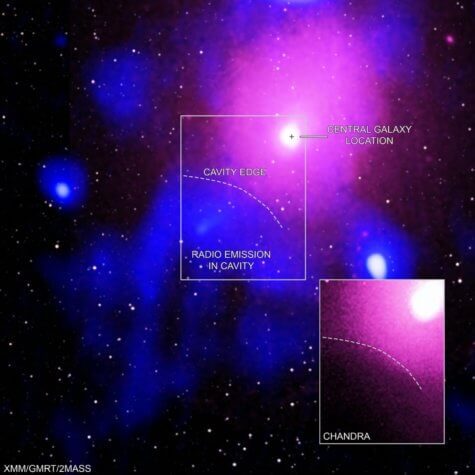PERTH, Australia — The mysteries of outer space never cease to astound the brightest scientists nor the novice astronomer gazing at the skies from his or her own backyard. That’s especially true following an unprecedented event recently observed in the cosmos. Astronomers in Perth, Australia detected the largest explosion ever found in the universe since the Big Bang.
Researchers at the Curtin University section of the International Centre for Radio Astronomy were observing a distant galaxy cluster when they detected a huge explosion at the center of a supermassive black hole in a galaxy about 390 million light-years from Earth. The explosion released five times more energy than the previous universal record holder.

“We’ve seen outbursts in the centers of galaxies before but this one is really, really massive,” said Curtin University professor Melanie Johnston-Hollitt in a statement. “And we don’t know why it’s so big. But it happened very slowly — like an explosion in slow motion that took place over hundreds of millions of years.”
The area of space where this occurred is called the Ophiuchus galaxy cluster. The explosion was so powerful it blew a hole in the cluster plasma surrounding the supermassive black hole. Cluster plasma is super-heated gas around a black hole, a telltale sign of supermassive black holes, which can be found at the center of many galaxies, including our own.
Lead study author Dr. Simona Giacintucci, who works at the Naval Research Laboratory in the U.S., likened the explosion to the eruption of Mount St. Helens in 1980, in which the top of the mountain was blown off.
“The difference is that you could fit 15 Milky Way galaxies in a row into the crater this eruption punched into the cluster’s hot gas,” she said.
X-ray telescopes detected the cavity in the black hole’s cluster plasma before, but astronomers at first discarded the theory that it could have been caused by an energetic explosion because the outburst was believed to be too big.
“People were skeptical because the size of outburst,” Johnston-Hollitt said. “But it really is that. The Universe is a weird place.”
The scientists realized what they discovered when they observed the Ophiuchus cluster with radio telescopes. The radio data matched the x-ray data, confirming a large expulsion of energy.
Four telescopes were used to detect and confirm the eruption: NASA’s X-ray Observatory, ESA’s XMM-Newton, the Murchison Widefield Array (MWA) in Western Australia, and the Giant Metrewave Radio Telescope (GMRT) in India.

Galaxy cluster expert Johnston-Hollitt, who directs the MWA, compared the discovery to that of uncovering the first dinosaur bones. She says that with new tools like low-frequency radio telescopes, they can “dig” deeper into space to uncover unusual discoveries like this that illuminate new aspects of the universe and its history, similar to archaeology.
Johnston-Hollitt also points out that studying the universe at different wavelengths will continue to uncover never-before-seen phenomena.
“We made this discovery with Phase 1 of the MWA, when the telescope had 2048 antennas pointed towards the sky,” she said. “We’re soon going to be gathering observations with 4096 antennas, which should be ten times more sensitive. I think that’s pretty exciting.”
The study was published in The Astrophysics Journal.
